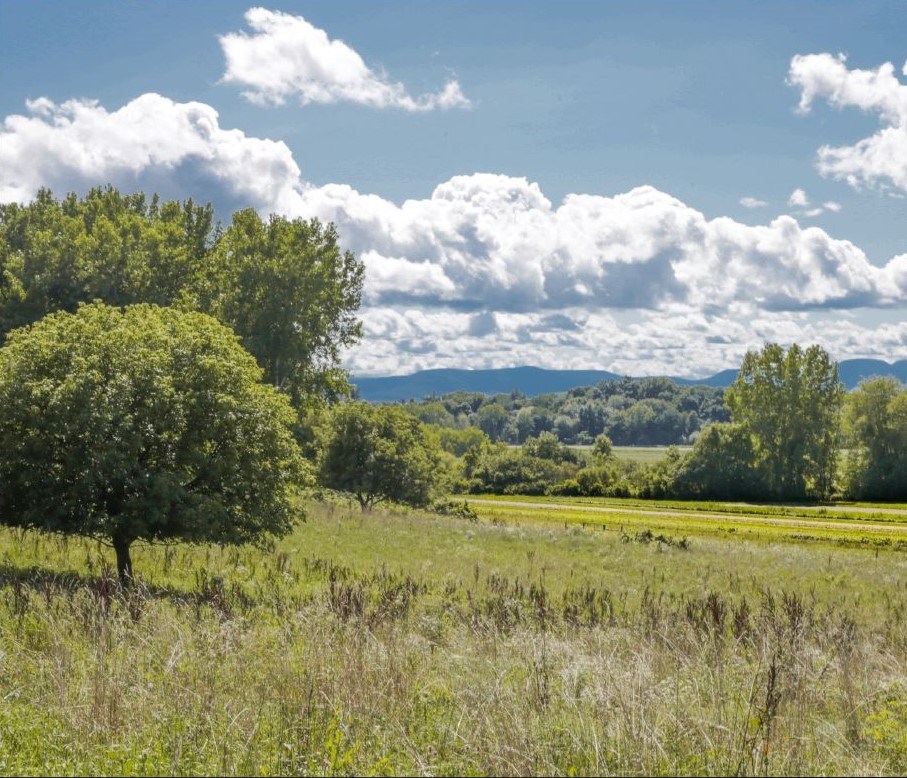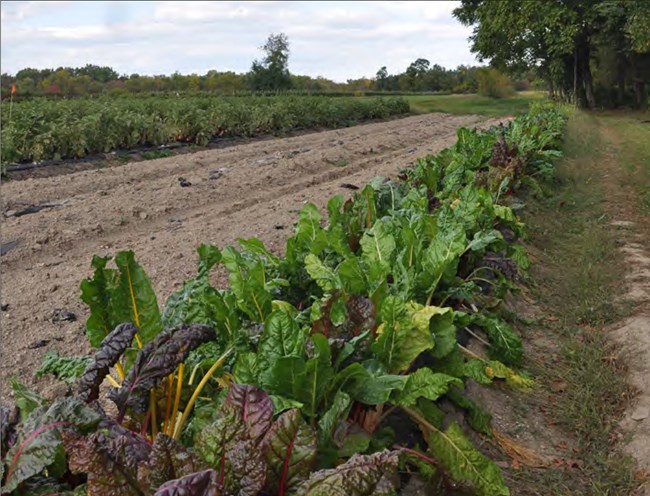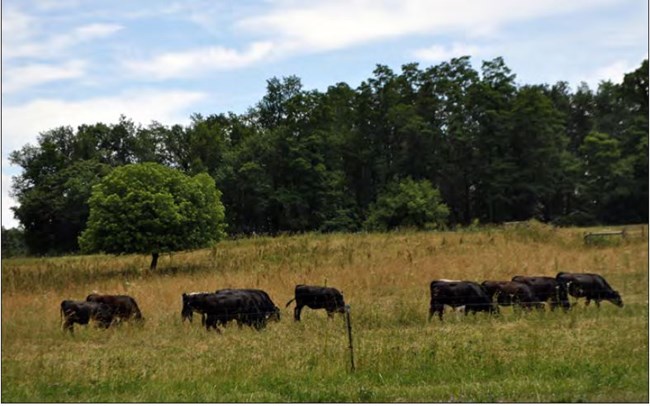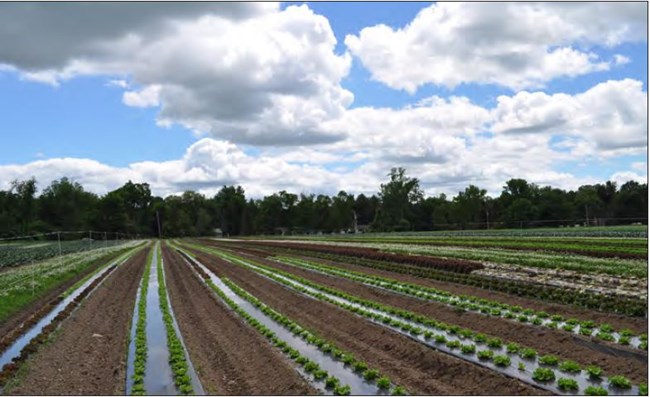Last updated: July 20, 2020
Article
Martin Van Buren National Historic Site Landscape

NPS
— Martin Van Buren, 1843“The Whigs would hardly believe that a much larger portion of my time is taken up with devising ways & means to multiply the quantity & improve the quality of manure than in forming political plans or any such matter.”
Martin Van Buren and Scientific Agriculture
At a time when the country was debating slavery, Martin Van Buren used his estate, which he named Lindenwald, to demonstrate that progressive agriculture techniques could increase profitability and sustain future generations of farmers using free labor rather than enslaved individuals. These techniques included increasing soil fertility, adopting new varieties of crops and breeds of livestock, and using crop rotation. He believed that progressive farming could make a positive impact on society and was critical to the future of American democracy.

NPS / OCLP
In all aspects of the Lindenwald enterprise, Van Buren sought to use cutting-edge breeds, seeds, and techniques. The former president was a self-conscious participant in a movement that sought to reform American agriculture by convincing farmers to reject wasteful, tradition-bound ways of farming in favor of scientific, profit-calculating, and soil-preserving practices. Agricultural reformers encouraged farmers to augment soil fertility and to choose the crops and animals that were best suited to the soil of their particular farms. They pressed farmers to carefully calculate the costs, savings, and monetary rewards of each farm technique and decision; alter their inputs and crops to take advantage of both market shifts and the specific quality of their soil; and strive to increase the productivity of farm labor.
No issue (save the fate of the Democratic party) elicited Van Buren’s enthusiasm more than fertilizer. Van Buren used numerous techniques, all of them actively promoted in the agricultural reform press, to raise the fertility of Lindenwald’s soils. The most important was animal manure. He required his tenant farmers to keep all animal manure on the farm, and he made extensive use of English grasses like Timothy, and clover, as well as an American grass, Redtop, to restore the depleted soil. He also made regular use of commercial fertilizers and soil conditioners like ashes, plaster, and lime.

NPS / OCLP
Van Buren planted new varieties of fruit trees from locales as diverse as Hamburg, Germany and Wayne County, New York. He made exclusive use of Carter’s potatoes, a special breed with a reputation for both extraordinary productivity and good eating. When he planted wheat, he made use of another special breed, Pure Soule’s. His bull and at least some of his milk cows were full-blooded Durham cattle. And he continually experimented with new crop breeds recommended by correspondents of the agricultural reform press. He also adopted new technology and techniques, buying a new subsoil plow and purchasing the right to use a new technique for composting corn stalks in the early 1840s. Although the size and species that cover the historic vegetated escarpment have changed over time, the topography of the escarpment remains intact.

NPS/OCLP

NPS
Landscape Significance
The Lindenwald Mansion and thirteen surrounding acres became a National Historic Landmark in 1961 and was listed in the National Register of Historic Places in 1966 with the passage of the National Historic Preservation Act. The historic district derives its primary historical significance under National Register of Historic Places Criterion A and B in the area of politics/government, for its associations with President Martin Van Buren (1782–1862) and his political career during the years between 1841 and 1848. During that period, Van Buren, who moved to Lindenwald after his single term as President of the United States (1837–1841), launched two unsuccessful but historically notable campaigns to regain the presidency in 1844 and 1848.The district is also significant under Criterion B as the only surviving property associated with the life of Martin Van Buren. Lindenwald, the only home that Van Buren ever owned, represents the culmination of a remarkable political career that saw him rise from meager beginnings as a Kinderhook tavern-keeper’s son to become the eighth President of the United States. His subsequent development of Lindenwald into a country estate and working farm reflected his Jeffersonian beliefs in the value and virtue of agriculture to a democratic society.
Lindenwald is locally significant under Criterion C in the area of architecture as an important example of a Federal-style mansion that was redesigned by architect Richard Upjohn in the Italianate-style of the mid-nineteenth century. The district is significant under Criterion D in the area of archeology as a property that has yielded, or may be likely to yield, information important in history, addressing research questions about the uses of this land before and after Van Buren's ownership.
Innovative Agricultural Management Guidelines
In 2018, the NPS published Agricultural Management Guidelines for the Martin Van Buren National Historic Site, a document that was developed in collaboration with an agricultural partner, Roxbury Farm. The guidelines identify best management practices for practicing sustainable agriculture within a historically significant cultural landscape in a way that protects resources, enriches the visitor experience, and promotes a viable agricultural operation. Roxbury Farm, a biodynamic farm operated as a community supported agricultural facility, currently leases a portion of the NPS-owned site for agricultural purposes.
NPS
On this backdrop of varying land ownership and interests, the guidelines serve as a tool to help park managers perpetuate the historic integrity of the cultural landscape by supporting the agricultural pursuits by collaborative organizations, including Roxbury Farm. Recognizing that the goals of historic preservation do not always reconcile easily with the agricultural processes influenced by climate, pests, and market demand, the Guidelines integrate best agricultural management practices with national standards for the management of cultural properties. It is one of the first Agricultural Management Guidelines in the National Park System, developed as a collaboration of agricultural, nonprofit, and cultural resource professionals.
Sustainable practices at the site include proper stewardship of the agricultural soil to promote long ecosystem health. The agricultural soil at Martin Van Buren National Historic Site is identified as an important cultural resource in the park’s recently completed General Management Plan. In addition, water management practices include methods of conserving water, irrigating crops, coping with flooding, draining fields as necessary, and managing on site surface water such as farm ponds and wells. Crop rotation is also an integral component of sustainable agriculture and is used to manage weeds, pests, and diseases while promoting soil health. Crop and breed selection should be consistent not only with needs identified in the park’s cultural landscape report but also with maintenance of a sound environment. Lastly, agricultural infrastructure and storage including barns, outbuildings, greenhouses, storage facilities, power sources, and utilities are central to the logistical and economic viability of agricultural operations on the Van Buren farm land. Vegetable production, for example, is dependent on infrastructure and storage facilities.
- Duration:
- 5 minutes, 2 seconds
At the Martin Van Buren National Historic Site, the National Park Service collaborates with Roxbury Farm CSA, the Open Space Institute, and the Olmsted Center for Landscape Preservation to preserve President Martin Van Buren's historic farmland by supporting sustainable agriculture now and for generations to come.
Quick Facts
- Cultural Landscape Type: Historic Site
- National Register Significance Level: National
- National Register Significance Criteria: A, B, C, & D
- Period of Significance: 1797, 1839–1862
- National Historic Landmark
Landscape Links
- Agricultural Management Guidelines for Martin Van Buren National Historic Site (2018)
- Cultural Landscape Report for Martin Van Buren National Historic Site, Volume II (2016)
- Cultural Landscape Report for Martin Van Buren National Historic Site, Volume I (1995)
-
National Register of Historic Places: Martin Van Buren National Historic Site
- Library of Congress: American Memory Collection
- NPGallery Photos
- More about NPS Cultural Landscapes
Tags
- martin van buren national historic site
- ner
- agricultural history
- agricultural landscape
- agriculture grounds
- cultural landscape report
- profile
- soil
- crops
- farming
- cultural landscape
- sustainability
- partnership
- science
- scientific agriculture
- agriculture
- president
- martin van buren
- politics
- historic orchard

